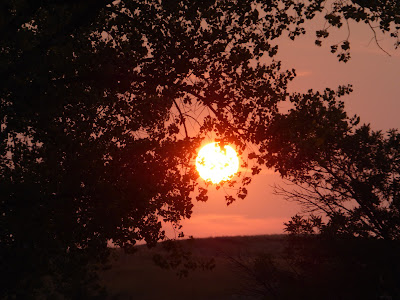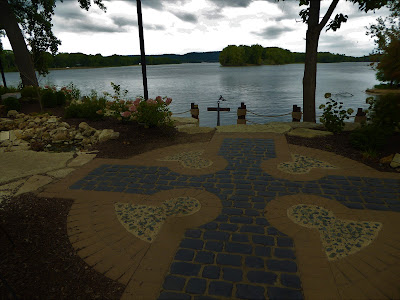The Badlands heating up
The thermometer hit 96 degrees our first day in the Badlands. We were able to get out and see some of the sights before it heated up too much but decided to get up and on the trail by 7 am the next morning. It was good to have the hiking boots back on.
As we were heading out for our peaceful early morning hike, we came up on this big horn sheep. We gave him plenty of room. He didn't seem bothered by us as he dozed in the sunshine.
The air was nice and cool with a breeze in the morning.
Erosion began in the Badlands about 500,000 years ago when the Cheyenne River captured streams and rivers flowing from the Black Hills into the Badlands region causing erosion to start. Modern rivers cut down through the rock layers, carving fantastic shapes into what had once been a flat floodplain. The Badlands erode at the rapid rate of about one inch per year and will erode completely away in another 500,000 years, giving them a life span of just one million years. Not a long period of time from a geologic perspective.
This guy was still hanging around once we returned from our hike. We also saw small deer and prong horn antelope. Fortunately, no rattlesnakes.
The sea that covered this area drained away with the uplift of the Black Hills and Rocky Mountains, exposing the black ocean mud to air. Upper layers were weathered into a yellow soil, called Yellow Mounds. The mounds are an example of a fossil soil, or paleosol. Each of the colors and layers represent an era thousands of years in the making.
We ran across a huge herd of bighorn as we were leaving the park in the morning but were too far away for a good picture. There were plenty near the road and sometimes blocking our path.
This must be the way to the Notch.
After wandering through a canyon, this trail climbs a log ladder and follows a ledge to "the Notch" for a view of the White River Valley. We watched for drop-offs. Not recommended for anyone with a fear of heights. It could be treacherous during or after heavy rains.
Climbing down turned out to be a little more difficult. The top stairs were quite steep and long steps for short legs. As I was climbing down backwards and my knees bending up to my chest the lower I got, Mike told me to turn around and try going forward. It had leveled out enough that I just walked instead of practically bear crawling backwards.
OK we will keep to the right since it looks like a person could easily slide on the gravel.
We tied several trails together and made a nice day of hiking. One trail had molds of the fossils that had been found in the area and the history. Alligator fossils indicate that a lush, subtropical forest covered the land. Most fossils found in this formation are from early mammals like the three-toed horse and the large titanothere. You can google that one if you are curious.
We managed to pick up a few geocaches in the town just outside the park after our hike in the small town of Interior . They must be hardy people that live in Interior with hot summers and tough winters.
For eleven thousand years, American Indians have used this area for their hunting grounds. Archaeological records indicate that these people camped in secluded valleys where fresh water and game were available year round. Eroding out of the stream banks today are the rocks and charcoal of their campfires, as well as the arrowheads and tools they used to butcher bison, rabbits, and other game. From the top of the Badlands Wall, they could scan the area for enemies and wandering herds.
Toward the end of the 19th century as homesteaders to claim moved into South Dakota to claim their 160 acre homesteads. The U.S. government stripped American Indians of much of their territory and forced them to live on reservations.


























































